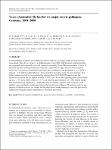Years of potential life lost for six major enteric pathogens, Germany, 2004–2008
Werber, Dirk
Hille, Katja
Frank, Christina
Dehnert, Manuel
Altmann, Doris
Müller-Nordhorn, J.
Koch, Judith
Stark, Klaus
In industrialized countries, acute infectious enteric diseases are usually mild, but they can also cause death. They do so, however, at different ages. Using 2004–2008 German notification data, we computed and compared crude and premature mortality [three different measures of years of potential life lost (YPLL)] of illnesses caused by Campylobacter spp., Listeria monocytogenes, norovirus, rotavirus, non-typhoidal Salmonella spp., and Shiga toxin-producing E. coli (STEC). Among ∼1·5 million notified illnesses, those caused by norovirus were the most frequent. The highest annual mortality was registered for salmonellosis (0·55/1 000 000 population), but listeriosis accounted for the highest number of YPLL (n=4245). Disregarding death at advanced age (i.e. >70 years), STEC illness (n=757) and rotavirus gastroenteritis (n=648) ranked second and third, following listeriosis (n=2306). Routine surveillance captures only a fraction of all incident cases and deaths, under-ascertaining the true burden of disease. Weighting death by age permits a different view on the disease burden individual enteric pathogens cause and particularly underscores the public health importance of listeriosis prevention.
No license information

